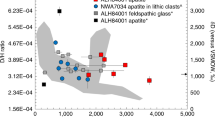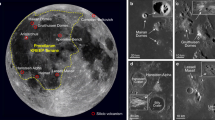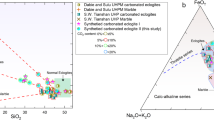Abstract
IT IS often argued1-3 that substantially more carbon dioxide and water were degassed from the martian interior than can be found at present in the atmosphere, polar caps and regolith. Calculations have shown that atmospheric escape cannot account for all of the missing volatiles4. Suggestions that carbon dioxide is stored as marine or lacustrine deposits5, are challenged by Earth-based and spacecraft remote-sensing data6,7. Moreover, recent modelling of the martian atmosphere suggests that rainfall or open bodies of water are in any case unlikely to have persisted for extended periods of time8,9. Hydrothermal carbonates therefore provide a possible solution to this dilemma. Using an accessible terrestrial system (Iceland) as a guide to the underlying processes, and a host rock composition inferred from the least-altered martian meteorite10, we present a geochemical model for the formation of carbonates in possible martian hydrothermal systems. Our results suggest that an extensive reservoir of carbonate minerals—equivalent to an atmospheric pressure of carbon dioxide of at least one bar—could have been sequestered beneath the surface by widespread hydrothermal activity in the martian past.
This is a preview of subscription content, access via your institution
Access options
Subscribe to this journal
Receive 51 print issues and online access
$199.00 per year
only $3.90 per issue
Buy this article
- Purchase on Springer Link
- Instant access to full article PDF
Prices may be subject to local taxes which are calculated during checkout
Similar content being viewed by others
References
Carr, M. H. Icarus 68, 187–216 (1986).
Fanale, F. P., Postawko, S. E., Pollack, J. B., Carr, M. H. & Pepin, R. O. in Mars (eds Kieffer, H. H., Jakosky, B. M., Snyder, C. W. & Matthews, M. S.) 1135–1179 (Univ. of Arizona Press, Tucson, 1992).
Squyres, S. W., Clifford, S. M., Kuzmin, R. O., Zimbleman, J. R. & Costard, F. M. in Mars (eds Kieffer, H. H., Jakosky, B. M., Snyder, C. W. & Matthews, M. S.) 523–556 (Univ. of Arizona Press, Tucson, 1992).
Jakosky, B. M., Pepin, R. O., Johnson, R. E. & Fox, J. L. Icarus 111, 271–288 (1994).
Nedell, S. S., Squyres, S. W. & Andersen, D. W. Icarus 70, 409–441 (1987).
Blaney, D. L. & McCord, T. B. J. geophys. Res. 94, 10159–10166 (1990).
Pollack, J. B. et al. J. geophys. Res. 95, 14595–14627 (1990).
Kasting, J. F. Icarus 94, 1–13 (1991).
Haberle, R. M., Tyler, D., McKay, C. P. & Davis, W. L. Icarus 109, 102–120 (1994).
Stolper, E. & McSween, H. Y. Jr Geochim. cosmochim. Acta 43, 1475–1498 (1979).
Newsom, H. E. Icarus 44, 207–216 (1980).
Arnörnsson, S., Gunnlaugsson, E. & Svavarsson, H. Geochim. cosmochim. Acta 47, 547–566 (1983).
Sveinbjornsdóttir, A. E., Coleman, M. L. & Yardley, B. W. D. Contr. Miner. Petrol. 94, 99–109 (1986).
Pálmason, G. & Sæmundsson, K. A. Rev. Earth Planet. Sci. 2, 25–50 (1974).
Mehegan, J. M., Robinson, P. T. & Delaney, J. R. J. geophys. Res. 87, 6511–6524 (1982).
Exley, R. A. J. geophys. Res. 87, 6547–6557 (1982).
Viereck, L. G., Griffin, B. J., Schmincke, H.-U. & Pritchard, R. G. J. geophys. Res. 87, 6459–6476 (1982).
Lonker, S. W., Franzon, J. & Kristmannsdóttir, H. Am. J. Sci. 293, 605–670 (1993).
Helgeson, H. C. in Geochemistry of Hydrothermal Ore Deposit 3rd edn (ed. Barnes, H. L.) 568–610 (Wiley, New York, 1979).
Wolery, T. J. & Daveler, S. A. EQ6. A Computer Program for Reaction Path Modeling of Aqueous Geochemical Systems. Theoretical Manual, User's Guide, and Related Documentation. (Version 7) (UCRL-MA-110662 PT IV, Lawrence Livermore Nat. Lab., Livermore, CA, 1986).
Carmichael, I. S. E. J. Petrology 5, 435–460 (1964).
Mittlefehldt, D. Meteoritics 29, 214–221 (1994).
Romanek, C. S. et al. Nature 372, 655–657 (1994).
Treiman, A. H. Meteoritics 30, 294–302 (1995).
Jull, A. J. T., Eastoe, C. J., Xue, S. & Herzog, G. F. Meteoritics 30, 311–318 (1995).
Shock, E. L. Origins Life Evol. Biosph. 22, 67–107 (1992).
Walter, M. R. & Des Marias, D. J. Icarus 101, 129–143 (1993).
Author information
Authors and Affiliations
Rights and permissions
About this article
Cite this article
Griffith, L., Shock, E. A geochemical model for the formation of hydrothermal carbonates on Mars. Nature 377, 406–408 (1995). https://doi.org/10.1038/377406a0
Received:
Accepted:
Issue Date:
DOI: https://doi.org/10.1038/377406a0
This article is cited by
-
Outgassing History and Escape of the Martian Atmosphere and Water Inventory
Space Science Reviews (2013)
-
Geochemistry of Carbonates on Mars: Implications for Climate History and Nature of Aqueous Environments
Space Science Reviews (2013)
-
Volatile Trapping in Martian Clathrates
Space Science Reviews (2013)
-
A possible high-temperature origin for the carbonates in the martian meteorite ALH84001
Nature (1996)
Comments
By submitting a comment you agree to abide by our Terms and Community Guidelines. If you find something abusive or that does not comply with our terms or guidelines please flag it as inappropriate.



